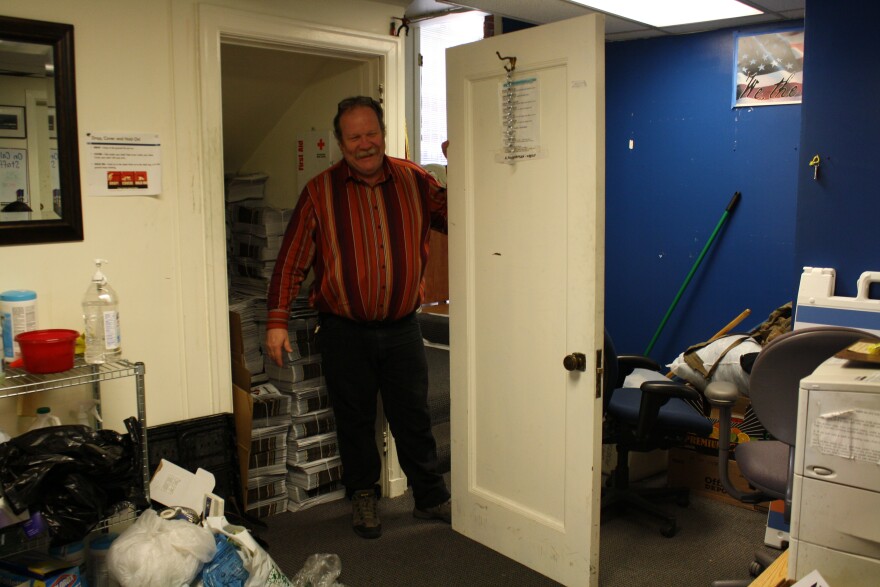Pioneer Square has stopped settling, or so say Washington State Department of Transportation officials. They’re monitoring 20 buildings in this old downtown Seattle quarter, some of which have sunk up to 1.4 inches since 2010. But some building owners are nervous, especially in light of news that effort to rescue Bertha, the massive tunnel boring machine, may be causing further sinking.
[asset-images[{"caption": "Tourists wait to enter the Seattle Underground Tour. In the foreground, a sidewalk that doubles as the ceiling of an underground bar beneath The Merchant's Cafe appears to be collapsing.", "fid": "106633", "style": "card_280", "uri": "public://201412/IMG_4253.JPG", "attribution": "Credit KUOW Photo/Joshua McNichols"}]]Mike Patrone owns multiple restaurants in Pioneer Square -- two with crumbling basements. He has been all over the news showing off the crack in the basement of the J&M Café, a crack whose expansion he blames on Pioneer Square’s settling soil around Bertha’s rescue site.
He recently showed me his second building, the Merchant’s Café and Saloon.
Our tour began at the street level, where the sidewalk seemed to crumble into a void below. Patrone then led me through the street level bar, down into the basement, where he showed me a second bar, locked up behind a metal gate. It was once a brothel, apparently, which isn't suprising given this neighborhood's notoriously rowdy past.
“This is a hidden gem that no one actually knows about that’s down here,” Patrone said.
This basement was once at street level, before the city raised the level of the streets to get Seattle out of the mud. The ceiling above the bar is the current sidewalk. In the storeroom to the right, the ceiling is a mess of cracks and leaks.
“It was solid-as-a-rock cement, nice and sealed – and you can see where the paint’s all cracking now and the water’s just coming in,” he said. All that damage occurred within the last few months, he said.
As with the J&M Café, Patrone blames Bertha for the structural failures at The Merchant Café and Saloon.
"If someone were standing on the sidewalk above when the ceiling falls in," Patrone said, “somebody could get killed.”
[asset-images[{"caption": "Though residents there have not seen cracks in the walls, the condo board at 80 South Jackson has talked about hiring an outside consultant to double check WSDOT's assertion that the building hasn't settled.", "fid": "106634", "style": "card_280", "uri": "public://201412/IMG_4246.JPG", "attribution": "Credit KUOW Photo/Joshua McNichols"}]]I asked Washington State Department of Transportation spokesperson Laura Newborn if WSDOT was worried about building owners blaming every crack in the wall or stuck door on the ground settlement around Bertha’s rescue site.
“No,” she said. “Building owners have been cooperative and have even helped us distinguish new cracks from old cracks.”
Suspicious Residents
Others are skeptical. Darren Augenstein lives in a condo building nearby. He said he’s a fan of the waterfront redevelopment project – he’ll have a better water view when it’s finished. He said the condo owners in his building haven’t seen suspicious cracks; the state told them the building hasn’t sunk.
But his neighbors don’t trust the state’s word. At a recent condo meeting, they talked about hiring a consultant.
“Essentially, we want to at least get an independent review," he said.
And a block away at the Real Change newspaper office, Neil Lampi showed me a closet where extra newspapers are stored before being recycled. Real Change is Seattle's homeless newspaper, headquartered in Pioneer Square.
“The door has always been a little sticky,” he said. But after workers started pumping out water to rescue Bertha, Lampi said the door got stickier.
“A couple of months ago, we had to take it off the hinges in order to get it out of the door jamb. It was completely stuck.”
A coworker asked Lampi if the tunnel project was the reason the door got stuck. “We’re saying it is now,” he said. “I put two and two together. It makes sense.”

